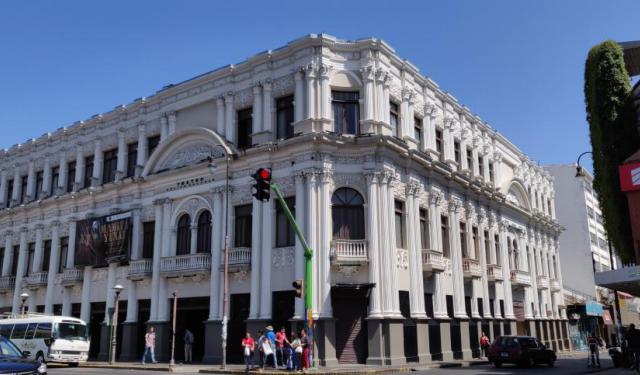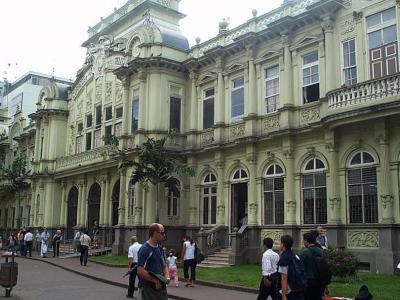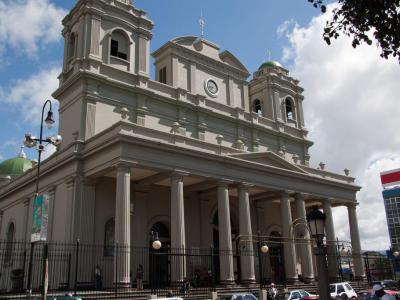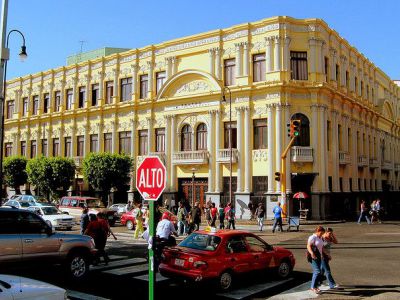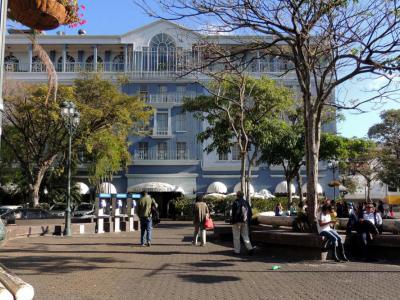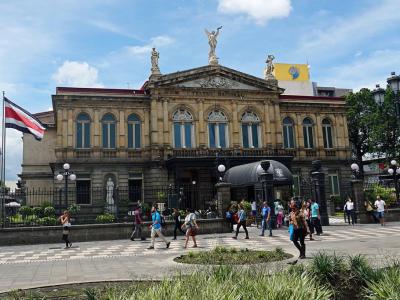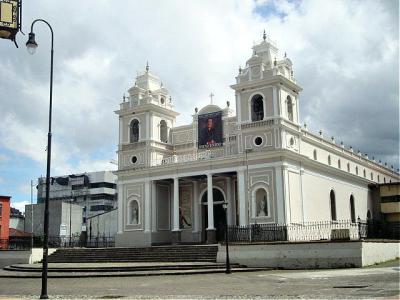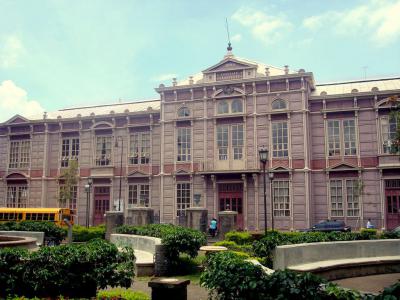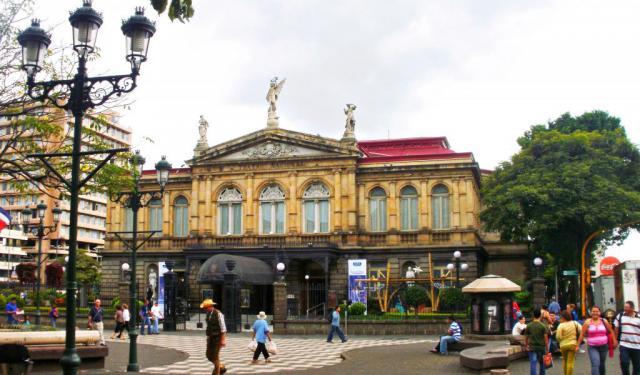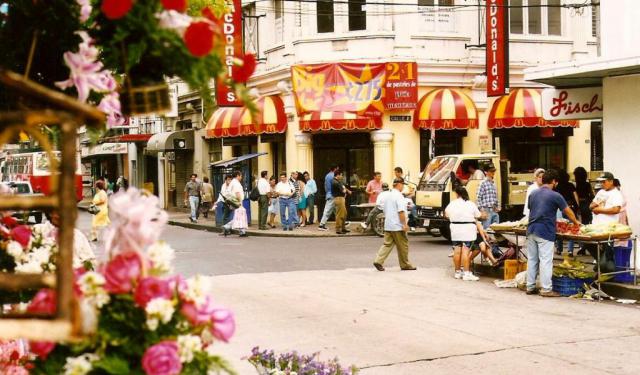Historical Buildings Tour (Self Guided), San Jose
What's known today as San Jose, the capital of Costa Rica, came into being as a small settlement during the Spanish invasion, circa the mid-16th century. From a town of little importance, San Jose eventually evolved into a densely-populated cosmopolitan city, built mostly with proceeds from coffee trade.
The historic architecture of San Jose is a mix of European and Latin American styles with buildings dating back mostly to the end of the 19th – beginning of the 20th centuries. Just as imposing today as they were 100 years ago, these former benchmarks of good taste and prosperity, having survived numerous demolitions and works carried out in the heart of the capital over time, continue silently observing the ongoing history of San José amid its daily hustle and bustle.
Central Post Office – a monumental, elegant structure of an eclectic style and notable French influence, built between 1914 and 1917. Metropolitan Cathedral – originally mud-and-straw, this 18th-century church eventually took the shape of a concrete edifice with Salomonic columns that had survived numerous earthquakes prior to being remodeled and converted into the Metropolitan Cathedral it is today.
Teatro Popular Melico Salazar – completed in 1928; was renamed in the 1980s to honor Manuel “Melico” Salazar, one of the most recognized Costa Rican opera stars. Grand Hotel Costa Rica – one of the most distinguished hotels in San Jose, built in 1928-1930; many famous international guests traveling to Costa Rica have stayed here. The National Theater – built from 1890 to 1897; an ambitious project funded by local coffee oligarchs. Lavishly adorned with sculptures and paintings by renowned Italian artists.
For a closer look at these and other prominent monuments of historic architecture in San Jose, take this self-guided walking tour.
The historic architecture of San Jose is a mix of European and Latin American styles with buildings dating back mostly to the end of the 19th – beginning of the 20th centuries. Just as imposing today as they were 100 years ago, these former benchmarks of good taste and prosperity, having survived numerous demolitions and works carried out in the heart of the capital over time, continue silently observing the ongoing history of San José amid its daily hustle and bustle.
Central Post Office – a monumental, elegant structure of an eclectic style and notable French influence, built between 1914 and 1917. Metropolitan Cathedral – originally mud-and-straw, this 18th-century church eventually took the shape of a concrete edifice with Salomonic columns that had survived numerous earthquakes prior to being remodeled and converted into the Metropolitan Cathedral it is today.
Teatro Popular Melico Salazar – completed in 1928; was renamed in the 1980s to honor Manuel “Melico” Salazar, one of the most recognized Costa Rican opera stars. Grand Hotel Costa Rica – one of the most distinguished hotels in San Jose, built in 1928-1930; many famous international guests traveling to Costa Rica have stayed here. The National Theater – built from 1890 to 1897; an ambitious project funded by local coffee oligarchs. Lavishly adorned with sculptures and paintings by renowned Italian artists.
For a closer look at these and other prominent monuments of historic architecture in San Jose, take this self-guided walking tour.
How it works: Download the app "GPSmyCity: Walks in 1K+ Cities" from Apple App Store or Google Play Store to your mobile phone or tablet. The app turns your mobile device into a personal tour guide and its built-in GPS navigation functions guide you from one tour stop to next. The app works offline, so no data plan is needed when traveling abroad.
Historical Buildings Tour Map
Guide Name: Historical Buildings Tour
Guide Location: Costa Rica » San Jose (See other walking tours in San Jose)
Guide Type: Self-guided Walking Tour (Sightseeing)
# of Attractions: 7
Tour Duration: 1 Hour(s)
Travel Distance: 1.7 Km or 1.1 Miles
Author: john
Sight(s) Featured in This Guide:
Guide Location: Costa Rica » San Jose (See other walking tours in San Jose)
Guide Type: Self-guided Walking Tour (Sightseeing)
# of Attractions: 7
Tour Duration: 1 Hour(s)
Travel Distance: 1.7 Km or 1.1 Miles
Author: john
Sight(s) Featured in This Guide:
- Edificio Correos Central ( Central Post Office)
- Catedral Metropolitana (Metropolitan Cathedral )
- Teatro Popular Melico Salazar
- Grand Hotel Costa Rica
- Teatro Nacional (National Theater)
- Iglesia La Soledad
- Edificio Metalico
1) Edificio Correos Central ( Central Post Office)
The Correo Central is the old historic Central Post Office of San Jose, Costa Rica. The neat thing is that it is still in full operation today. It was first opened in 1917, though the overall architectural design of the building would suggest that it is much older.
On the first floor of the building there is a Stamp Museum that is pretty neat, especially seeing as how the hobby of stamp collecting is very popular in the country. You can get classic examples from the history of the country here. Plus, how often do you see a stamp museum in an operating post office? The area is open Monday through Friday from 7:00 a.m. until 9:00 p.m. It is also open 8:00 a.m. until noon on Saturdays. Admission to the museum is free, since it is part of the post office.
There is a small park that is located right next to the building, which is a great spot to stop and rest. Some of the most beautiful fig trees in the country are located here, and provide a peaceful resting place for the wearing traveler.
On the first floor of the building there is a Stamp Museum that is pretty neat, especially seeing as how the hobby of stamp collecting is very popular in the country. You can get classic examples from the history of the country here. Plus, how often do you see a stamp museum in an operating post office? The area is open Monday through Friday from 7:00 a.m. until 9:00 p.m. It is also open 8:00 a.m. until noon on Saturdays. Admission to the museum is free, since it is part of the post office.
There is a small park that is located right next to the building, which is a great spot to stop and rest. Some of the most beautiful fig trees in the country are located here, and provide a peaceful resting place for the wearing traveler.
2) Catedral Metropolitana (Metropolitan Cathedral ) (must see)
The Metropolitan Cathedral of San José, originally constructed in 1802, has long served as the spiritual heart of the city’s Catholic community. The early church, however, did not escape the region’s seismic activity—an earthquake in the early 1800s left the building damaged, prompting a major reconstruction in 1871.
The cathedral’s current design is a unique blend of Greek Orthodox, Neo-Classical, and Baroque styles, reflecting both European influence and local craftsmanship. Doric pilasters, a neo-classical pediment, and side steeples elegantly combine to honor the church’s historical origins while presenting a grand façade to the city.
Inside, the cathedral continues to impress with its finely tiled Colonial floors and beautifully crafted stained-glass windows, each depicting vivid biblical stories. Intricate wooden cherubs hover near the altar, where a carefully carved figure of Christ commands attention.
Beyond the artistic beauty, the cathedral is steeped in historical significance. In 1983, Pope John Paul II visited San José, leaving a lasting mark with a marble statue that now stands in the north garden, commemorating his presence. The cathedral’s crypt also holds historical treasures: the remains of two former archbishops and a Costa Rican president rest here, connecting the church not only to spiritual life but also to the nation’s political and cultural heritage.
Tip:
Although not technically part of the cathedral complex, a small statue of Holocaust victim Anne Frank graces the pedestrian mall on the building's south side. It was donated by the Embassy of the Netherlands.
The cathedral’s current design is a unique blend of Greek Orthodox, Neo-Classical, and Baroque styles, reflecting both European influence and local craftsmanship. Doric pilasters, a neo-classical pediment, and side steeples elegantly combine to honor the church’s historical origins while presenting a grand façade to the city.
Inside, the cathedral continues to impress with its finely tiled Colonial floors and beautifully crafted stained-glass windows, each depicting vivid biblical stories. Intricate wooden cherubs hover near the altar, where a carefully carved figure of Christ commands attention.
Beyond the artistic beauty, the cathedral is steeped in historical significance. In 1983, Pope John Paul II visited San José, leaving a lasting mark with a marble statue that now stands in the north garden, commemorating his presence. The cathedral’s crypt also holds historical treasures: the remains of two former archbishops and a Costa Rican president rest here, connecting the church not only to spiritual life but also to the nation’s political and cultural heritage.
Tip:
Although not technically part of the cathedral complex, a small statue of Holocaust victim Anne Frank graces the pedestrian mall on the building's south side. It was donated by the Embassy of the Netherlands.
3) Teatro Popular Melico Salazar
The Melico Salazar Popular Theater, an important architectural structure in Costa Rica, has a complex history. While it is large and designed in the European Baroque style, it is less elaborate than the nearby National Theater, which was influenced by Parisian architecture.
Originally built in 1799, the theater was destroyed by a devastating earthquake in 1828. Despite this setback, it was rebuilt and operated smoothly until 1849, when former President of Costa Rica Juan Rafael Mora and his army occupied the building, leaving behind hidden cannons beneath the floor.
Over the years, the theater underwent numerous changes. In 1918, it became a boys' institution, but this ended in 1924 after an earthquake damaged its structure. Jose Raventos recognized its potential and purchased the property, transforming it into an elegant theater named the Raventos Theater. The theater was a venue for operas and entertainment until a fire destroyed its interior in 1967.
The theater was refurbished and renamed the Popular Theater. In 1976, a renewed interest in the arts and music led to a complete renovation of the interior, resulting in its latest name change in 1980 to the Melico Salazar Popular Theater, in honor of Manuel "Melico" Salazar, a renowned Costa Rican tenor.
Currently, the theater displays artworks from the Spanish Museum of Art and features new cascading balconies, a rebuilt stage, and an orchestra dais. Visitors can attend events during its season from April to December.
Originally built in 1799, the theater was destroyed by a devastating earthquake in 1828. Despite this setback, it was rebuilt and operated smoothly until 1849, when former President of Costa Rica Juan Rafael Mora and his army occupied the building, leaving behind hidden cannons beneath the floor.
Over the years, the theater underwent numerous changes. In 1918, it became a boys' institution, but this ended in 1924 after an earthquake damaged its structure. Jose Raventos recognized its potential and purchased the property, transforming it into an elegant theater named the Raventos Theater. The theater was a venue for operas and entertainment until a fire destroyed its interior in 1967.
The theater was refurbished and renamed the Popular Theater. In 1976, a renewed interest in the arts and music led to a complete renovation of the interior, resulting in its latest name change in 1980 to the Melico Salazar Popular Theater, in honor of Manuel "Melico" Salazar, a renowned Costa Rican tenor.
Currently, the theater displays artworks from the Spanish Museum of Art and features new cascading balconies, a rebuilt stage, and an orchestra dais. Visitors can attend events during its season from April to December.
4) Grand Hotel Costa Rica
The Grand Hotel of Costa Rica is a true gem among the hotels of San Jose, Costa Rica, and it also happens to be the very first such hotel in the country. It was formed in 1928, and up till that time, there was no major first class hotel in the capital city. An act of the Constitutional Congress of the Republic of that year made it possible to get the hotel in town. The hotel got funding from the government, and in turn the hotel agreed to always sell Costa Rican coffee, as well as the hotel agreed to always keep two rooms available for the government to use for dignitaries and the like.
In 2004, President Abel Pacheco declared the hotel to be a national landmark of the country. The architecture of the place is also quite wonderful, expressing the best in Victorian style architecture. In recent times, the Choice International Hotel chain has acquired the hotel, and added it to its growing list of historic hotels that are being turned into Resorts. It remains a popular destination in the capital city not only because of its historicity, but because it also sits very close to the ocean and some of the best mountain side landscaping in the country.
On December 7th, 2004, the Gran Hotel Costa Rica was declared by the President of the country Abel Pacheco a historical-architectural landmark of Costa Rica, not only for being the first major hotel of the country, but also for its long trajectory, its architecture, which represents the San José of those years, and the historical complex it forms with other landmarks in the area.
In 2004, President Abel Pacheco declared the hotel to be a national landmark of the country. The architecture of the place is also quite wonderful, expressing the best in Victorian style architecture. In recent times, the Choice International Hotel chain has acquired the hotel, and added it to its growing list of historic hotels that are being turned into Resorts. It remains a popular destination in the capital city not only because of its historicity, but because it also sits very close to the ocean and some of the best mountain side landscaping in the country.
On December 7th, 2004, the Gran Hotel Costa Rica was declared by the President of the country Abel Pacheco a historical-architectural landmark of Costa Rica, not only for being the first major hotel of the country, but also for its long trajectory, its architecture, which represents the San José of those years, and the historical complex it forms with other landmarks in the area.
5) Teatro Nacional (National Theater) (must see)
The National Theater of Costa Rica stands as one of San José’s crown jewels, a monument to the city’s golden age of coffee wealth and cultural ambition. Construction began in 1891, and by 1897 the curtain rose on Goethe’s Faust, inaugurating what would become a symbol of national pride. Its creation was fueled, quite literally, by coffee — when export profits soared, a tax on the trade helped finance this grand temple of the arts.
Inside, the theater impresses with marble staircases, gilded ceilings, and ornate furnishings that would feel at home in Paris or Vienna. Every inch of its interior whispers of a time when San José dreamed big and refused to settle for provincial charm. The blend of European opulence and Costa Rican craftsmanship creates a stage that’s as captivating as any performance held there.
Outside, the statues of playwright Calderón de la Barca and composer Ludwig van Beethoven stand watch at the entrance, immortalized not only in bronze but also on the country’s currency. Today, the theater remains an active venue, hosting regular performances that keep its grand spirit alive — proof that art, like coffee, continues to be one of Costa Rica’s finest exports.
Tip:
If you have a ticket for a performance, ask for the free English tour included in the ticket price to learn a bit of history about the place.
Inside, the theater impresses with marble staircases, gilded ceilings, and ornate furnishings that would feel at home in Paris or Vienna. Every inch of its interior whispers of a time when San José dreamed big and refused to settle for provincial charm. The blend of European opulence and Costa Rican craftsmanship creates a stage that’s as captivating as any performance held there.
Outside, the statues of playwright Calderón de la Barca and composer Ludwig van Beethoven stand watch at the entrance, immortalized not only in bronze but also on the country’s currency. Today, the theater remains an active venue, hosting regular performances that keep its grand spirit alive — proof that art, like coffee, continues to be one of Costa Rica’s finest exports.
Tip:
If you have a ticket for a performance, ask for the free English tour included in the ticket price to learn a bit of history about the place.
6) Iglesia La Soledad
The Church of Our Lady of Solitude (Iglesia La Soledad) is a beautiful church located in the heart of downtown San Jose. This stunning church was built in the mid-nineteenth century and took over 30 years to complete. In 1999, it was recognized as part of the Historical and Architectural Heritage of the country.
The Church of Our Lady of Solitude was designed by the English architect Hugh G. Tonkin, at the request of the first Archbishop of Costa Rica, Anselmo Llorente y la Fuente. The construction of the church was done in masonry, with the influence of the Baroque style and wooden columns. The church's architecture and design are impressive and represent an important part of Costa Rica's cultural heritage.
One of the most remarkable features of the church is its beautiful stained glass windows, which were imported from Switzerland. These windows represent several biblical passages and add a unique touch to the already impressive church. Additionally, the church has several sculptures from the Stfulesser workshop, including the 14 Stations of the Cross, also called Way of the Cross.
The Church of Our Lady of Solitude played an important role in the development of the neighborhood of La Soledad. The church's construction gave birth to the neighborhood, which was already known as "Soledad" (loneliness) due to its few inhabitants at that time. Today, the church and the neighborhood are important landmarks in the city of San Jose.
The Church of Our Lady of Solitude was designed by the English architect Hugh G. Tonkin, at the request of the first Archbishop of Costa Rica, Anselmo Llorente y la Fuente. The construction of the church was done in masonry, with the influence of the Baroque style and wooden columns. The church's architecture and design are impressive and represent an important part of Costa Rica's cultural heritage.
One of the most remarkable features of the church is its beautiful stained glass windows, which were imported from Switzerland. These windows represent several biblical passages and add a unique touch to the already impressive church. Additionally, the church has several sculptures from the Stfulesser workshop, including the 14 Stations of the Cross, also called Way of the Cross.
The Church of Our Lady of Solitude played an important role in the development of the neighborhood of La Soledad. The church's construction gave birth to the neighborhood, which was already known as "Soledad" (loneliness) due to its few inhabitants at that time. Today, the church and the neighborhood are important landmarks in the city of San Jose.
7) Edificio Metalico
The Metallic Building (Edificio Metalico), also known as the Metallic School, is a historical building located in San Jose. It was built in 1896 and is situated in front of Morazán Park. This building is the headquarters of the Buenaventura Corrales School, which is one of the oldest primary education institutions in Costa Rica. The Metallic Building is considered one of the most representative buildings of the educational and industrial revolution that took place in the country.
The Metallic Building was inspired by the design of the Eiffel Tower and was made of wrought iron. It was designed and built in Belgium by architect Charles Thirion. The structure was transported to Costa Rica by ship and assembled on-site. The building was declared a relic of national historical and architectural interest on July 29, 1980.
The Metallic Building has a symmetrical composition with three volumes on its main façade and responds to neoclassical canons, which was a frequent historicist trend in Latin America at the time. The central volume coincides with the building for the assembly hall. The building is two stories and spans just over 2400 square meters. It is organized around two patios separated by the central body, and the patios are surrounded by corridors and balconies with richly ornamented railings.
Since its inauguration in 1886, the Metallic Building has functioned as a school and has housed two schools, one for boys and one for girls. Today, three schools merged under the name of Escuela Buenaventura Corrales operate in the Metallic Building. The Metallic Building is an iconic landmark in Costa Rica and a testament to the country's commitment to public education and infrastructure works that project into the future.
The Metallic Building was inspired by the design of the Eiffel Tower and was made of wrought iron. It was designed and built in Belgium by architect Charles Thirion. The structure was transported to Costa Rica by ship and assembled on-site. The building was declared a relic of national historical and architectural interest on July 29, 1980.
The Metallic Building has a symmetrical composition with three volumes on its main façade and responds to neoclassical canons, which was a frequent historicist trend in Latin America at the time. The central volume coincides with the building for the assembly hall. The building is two stories and spans just over 2400 square meters. It is organized around two patios separated by the central body, and the patios are surrounded by corridors and balconies with richly ornamented railings.
Since its inauguration in 1886, the Metallic Building has functioned as a school and has housed two schools, one for boys and one for girls. Today, three schools merged under the name of Escuela Buenaventura Corrales operate in the Metallic Building. The Metallic Building is an iconic landmark in Costa Rica and a testament to the country's commitment to public education and infrastructure works that project into the future.
Walking Tours in San Jose, Costa Rica
Create Your Own Walk in San Jose
Creating your own self-guided walk in San Jose is easy and fun. Choose the city attractions that you want to see and a walk route map will be created just for you. You can even set your hotel as the start point of the walk.
San Jose Introduction Walking Tour
Ricardo Jimenez Oreamuno, former president of Costa Rica, once said: “San Jose is the heart of Costa Rica, where the pulse of the nation beats.”
San Jose, Costa Rica's capital, has a rich history dating back to the early 19th century. The city's origins are tied to the country’s shift toward independence and urban development. Before becoming the capital, Costa Rica’s main... view more
Tour Duration: 2 Hour(s)
Travel Distance: 3.2 Km or 2 Miles
San Jose, Costa Rica's capital, has a rich history dating back to the early 19th century. The city's origins are tied to the country’s shift toward independence and urban development. Before becoming the capital, Costa Rica’s main... view more
Tour Duration: 2 Hour(s)
Travel Distance: 3.2 Km or 2 Miles
Shopping and Food Walking Tour
Walking the pedestrian-friendly promenades of Costa Rica's capital – San Jose – is a great way to experience the local culture. Despite an occasional rainstorm, the country's tropical weather makes outdoor shopping an undeniably fun experience. The downtown part of San Jose has no shortage of department stores, traditional marketplaces and souvenir shops selling handcrafts.
The... view more
Tour Duration: 1 Hour(s)
Travel Distance: 1.1 Km or 0.7 Miles
The... view more
Tour Duration: 1 Hour(s)
Travel Distance: 1.1 Km or 0.7 Miles
Useful Travel Guides for Planning Your Trip
17 Uniquely Costa Rican Things to Buy in San Jose
Not to be confused with San Jose, the sunny California, San Jose, Costa Rica is the capital city of a wet (250 centimeters of rainfall per year) and colorful Latin American country renowned for its diverse craftsmanship (courtesy of the numerous indigenous tribes), splendid coffee and rich cultural...
The Most Popular Cities
/ view all
